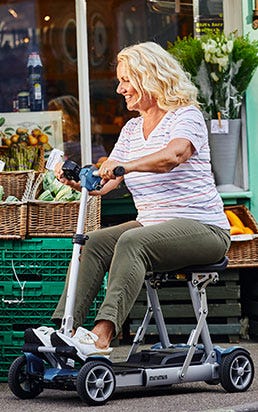Let’s talk bathrooms!
As an Occupational Therapist (OT) we categorise day-to-day life into chunks of Self Care, Productivity and Leisure. Some occupations within these areas are completed by choice and some by necessity. Self-care, including washing, dressing and hygiene practises are essential components in preventing many avoidable health issues, but also carry many elements of personal choice.
Here, I like to focus on the word personal – your routines, your priorities, your products, your abilities. With privacy and dignity intrinsic to so many personal care tasks, the option of having someone help you is often a last resort, with independence high on most people’s priorities to perform in this area.
With bathrooms in the UK often being one of the smallest in a property, the environmental constraints a bathroom presents with often add to the difficulties you may already be having.
Add to that the obvious hazards of water and slipping risks, and a bathroom soon becomes a daunting area opposed to the relaxing haven it used to be!
I’ve met too many people with stories of falls in bathrooms, whether slipping in the bath, tripping on a bathmat or struggling to fit their walking frame in the room, to not share some ideas on how to keep safe and independent with personal care at home.
How To Be Independent in the Bathroom
So how do you tackle independence with personal care? Well, the first thing to consider is whether you can change your abilities (with rehab), second is whether you can change the environment (to compensate) and third is whether you can do both.
Insight is also important here - to know what will help you most, you need to have a good understanding of what is available to you. Many health professionals and rehab teams can help you discover new ways of safely ‘moving’.
You can access OTs privately or through the NHS, virtually or face to face, in clinics or at home, and with some simple but personalised advice, they could teach you a new way to stay independent and confident in the bathroom.
Help With Using the Bath
Think about the bath – a frequent hurdle for people as they age or experience changes to their function due to the need to perform big movements, requiring much strength and balance whilst in a pool of water.
Traditional ways of stepping over the edge of a bath soon become hazardous and the thought of standing in a highly polished bath with wet feet to exit can be too risky for many. But with simple changes to techniques or adding equipment, you can regain your confidence and importantly keep your independence.
If you can sit on the bath edge and swing your legs over, then maybe think about a bath board, a bath seat, or hand rails - the options are plentiful but must be balanced with your individual ability and just as importantly your style choices and living circumstances; if you share your bathroom with others, your options may again be different. A walk-in bath may be one of the safer alternatives if you love baths.
Bath Boards
 The Bathmate Bathboard combines two elements of support, offering a way to slide over the bath rather than climb, and providing a handle to allow you a secure grip which will help you use your upper body to stabilise the transfer.
The Bathmate Bathboard combines two elements of support, offering a way to slide over the bath rather than climb, and providing a handle to allow you a secure grip which will help you use your upper body to stabilise the transfer.
This means you don’t have to risk damaging any tiles when adding wall-mounted hand rails, and you can remove the board in seconds for anyone else’s access, or even take it to another bathroom if you’re going away.
It takes up minimal storage space and is often used as a seat under an over bath shower as frequently as it is an aid to get into the bath itself.
A versatile and easy to use aid, which when combined with a long handled sponge can really help those who have reduced range of movement.
Some baths are just too narrow for boards, or do not have enough width to the ledges to support a board though; some are so low you would struggle to stand from a board as much as you would the base of the bath – in these cases having an OT advise on more specialist, personalised adaptations may be helpful.
Help With Showering
 If a shower is more your thing, the need to stand while washing often worries people. The small size of most showers can sometimes actually be helpful, meaning wall supports/rails are always within range, but it does then limit the options you have for seating devices.
If a shower is more your thing, the need to stand while washing often worries people. The small size of most showers can sometimes actually be helpful, meaning wall supports/rails are always within range, but it does then limit the options you have for seating devices.
For these you should consider whether the base of your cubicle is strong enough to use with a seat, the opening width of your doors to ensure you can get a seat through and the floor space left in the cubicle to stand once a seat is in situ - the benefits of a seat must be considered along with any trip or falls hazards the device then creates.
Often, dependent somewhat on your body size, a good choice is a wall mounted drop down seat like the Soho shower chair, but these are only possible if you have a solid wall to fix too, or if it is possible to fix direct into the timber studwork in the wall. A corner shower stool is another good way to make best use of a small space.
Sitting At The Basin
Sitting at the wash basin is often another option, something that is recommended by hospital discharge teams.
 Whether brushing your teeth, shaving or washing, sitting obviously reduces your risk of falling.
Whether brushing your teeth, shaving or washing, sitting obviously reduces your risk of falling.
A simple perching stool like the Versa Adjustable Perching Stool is a regular go to in these situations, offering an easy transfer with solid handles to push from, and a slanted seat to ease the transfer up to standing.
However, if you have a small room, the addition of a stool with splayed legs can sometimes actually cause more of a trip hazard.
In these situations, I find something like the AquaAid rotating stool (pictured above) of benefit – a great design idea which can even be used in the shower if needed. Do make sure you adjust the height before first use - simply having the right height seat can eliminate the need for you to pull on that sink or radiator any longer!
Falls can be devastating, but having a thorough check through your home and making minor changes can dramatically reduce home hazards.
In the bathroom, try an anti-slip mat in the bath or shower, make sure the room light is bright, and check that any belts on dressing gowns are tucked into pockets before walking.
It’s a good idea to use free resources like Worksheet: Home Safety Checklist (nih.gov) or contact your local community leisure facility for Falls Prevention Exercise groups to work on your overall health.
For more information on bathroom equipment options read my Recommended Bathroom Aids or ask your local OT for a home visit for truly personalised recommendations.


 Price Match Promise
Price Match Promise
 Next day delivery, 7 days a week
Next day delivery, 7 days a week
 Nationwide Showrooms
Nationwide Showrooms
 Rated Excellent
Rated Excellent






